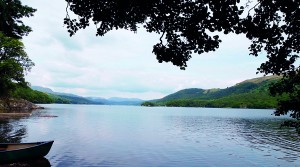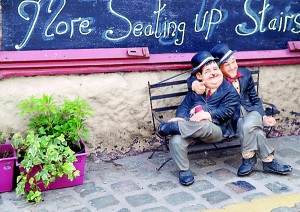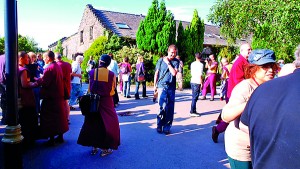Taming the mind amidst pristine beauty
England’s lovely Lakes District made for the perfect setting for a magical fortnight two months ago. Picturesque and peaceful, the lakelands of the northern county of Cumbria are infused with a pastoral beauty that moved poets and authors to settle down there and pen works that echoed across the world.

Conishead Priory (left inset) and (above) lakeside tranquility
William Wordsworth is said to be the district’s most famous son. Hawkshead Grammar School, which he attended, stands today, proudly proclaiming links to the prodigious poet in a plaque at its entrance and a desk on which the poet as a schoolboy etched his name. Authoress Beatrix Potter so loved the place she bought vast tracts of farmland there. Oscar Wilde settled down here for a while, and wrote Lady Windermere’s Fan, a play with characters and places drawn from Lake Windermere, England’s largest lake, and the nearby town of Windermere. The place is characterised by rolling hills, lakes, farmland, woodland, valleys and moors, all with a natural order that is extremely pleasing to the eye.
But it wasn’t the lovely land that drew me to Cumbria. I had travelled halfway around the world to confine myself to a corner of the countryside to participate in a remarkable convergence of cultures, drawn together to practise a philosophy originating halfway across the world. About 2,500 Buddhists were visiting the Conishead Priory, a massive Gothic building on the shores of Morecombe Bay, south of the Lake District, to learn and practise methods of moving their minds towards lasting states of peace. The priory is the headquarters of the New Kadampa Tradition – International Kadampa Buddhist Union, a Mahayana Buddhist tradition founded by Tibetan monk Geshe Kelsang Gyatso.

Remember Laurel and Hardy? Reminders that Ulverston is the hometown of Stan Laurel
Over two weeks, we sat together in the serene temple built in a section of the garden that had once been used to grow tomatoes, to study a week of Lamrim, a systematic 21-step set of practices that includes all the essential Heenayana and Mahayana teachings, as set out by Atisha (982-1054AD), a Bengali Buddhist master who led a revival of Buddhism in Tibet. He founded the original Kadampa Buddhist method, ka meaning the teachings of the Buddha and dam meaning Atisha’s Lamrim instructions. The second week was occupied with receiving and learning the practice of the highest yoga tantric empowerments, following the teachings of Je Tsongkapa, a 14th century Tibetan Buddhist master who clarified and streamlined Atisha’s teachings and brought tantra into equal prominence.
His teachings formed the New Kadampa Tradition. The practice focusses on the use of empowerments, the imagination and rituals to directly identify with tantric deities, in actuality representative of our own archetypal or purest states of mind. In combination, all the practices act as a powerful means of attaining enlightenment.
Geshe Gyatso arrived in Ulverston in 1973. He founded a new chapter of the tradition that has spread across the world, generating as many as 1,100 centres and branch centres in 40 countries. So, the summer retreat was a veritable united nations of Buddhists of every nationality, ranging from South African to Brazilian, Mexican, Chilean, almost every European nation, US, Indian, Nepalese, Cambodian, Chinese, Filipino, and Australian, all putting up in rooms, dorms or even camping out in tents.
Between sessions of teachings, empowerments, meditation and poojas, there was time to mingle. Mealtimes in the large dining marquee and the distribution of pooja offerings at the end of the day were social events. “It’s like Woodstock without the drugs and alcohol,” a jazz musician commented over lunch. Volunteering was a good way to make friends with other practitioners, and collect merit necessary for gaining dharma realisations. I did a day of chopping vegetables, washed dishes in the little café, and did a few shifts of the security watch.
And, I explored the town of Ulverston, the hometown of Stan Laurel, about a half mile away from the priory. It was only then that I realized that Laurel was not fictional, but a man born in Ulverston in 1890. He teamed up with Oliver Hardy to become one of the world’s best-loved comic duos, Laurel and Hardy.
Ulverston is immaculate and prosperous, judging from the luxury cars parked along the narrow roads. There were smiling courteous townsfolk everywhere. I learned they fiercely guard their town’s old-world charm, resisting attempts at  modernisation. A large supermarket chain had been turned away. In fact, the Lakes District is full of towns like Ulverston, all proud to maintain their charm and beauty.
modernisation. A large supermarket chain had been turned away. In fact, the Lakes District is full of towns like Ulverston, all proud to maintain their charm and beauty.
I also snuck away for a three-hour taxi tour through the lakelands. I was familiar with Beatrix Potter from her tales of Peter Rabbit that fanned my childhood imagination. She had spent much of her childhood in the Lakes District and her 23 books, including The Tale of Peter Rabbit and The Tale of Squirrel Nutkin, were inspired by her surroundings. With the money she earned from her books, she first bought the Hill Top Farm in the village of Near Sawrey and later expanded her property to 4,000 acres. The land was bequeathed to the National Trust and remains unspoilt today, with the local government working closely with the farmers to ensure that all its artefacts, like the dry stone walls built by Irish immigrants more than a century ago, are in excellent condition.
Conishead Priory too has an illustrious history. It has been through several incarnations. It was founded in 1160 as the home for leprosy sufferers, run by the monks of the order of St Augustine. It acquired priory status in 1180. In 1536, it was dismantled by King Henry VIII when he turned against the Catholics. Later restored, it has changed ownership several times, serving as a hydropathic spa and a convalescent home for miners, and the home of many generations of the Braddyl family notable as patrons of the arts, and as a hospital during World War II. It was empty and derelict when the Kadampa Buddhist group purchased it in 1942. Infested with wood rot, the building was revitalized by volunteers over the years. Today, a large and colourful statue of the Maitreya Buddha greets you at the entrance and maroon and yellow clad Buddhist monks walk its halls. The building fills up with crowds during the Spring, Summer and Autumn Kadampa Festivals. As a tourist attraction, it also receives about 15,000 visitors a year.
The Manjushri Meditation Centre, a serenely beautiful temple built in the form of the mandala of the Buddha of Compassion, stands in the garden. Also the handiwork of volunteers, its golden roof glints in the sun. It is the first in a series of temples worldwide dedicated to world peace.
At the end of fortnight, I left enriched with memories and new experiences. Kadampa Buddhism stresses on methods to protect the mind from its own harmful inclinations. The practices help us to be mindful before thinking, speaking and acting in ways that may hurt or harm others. Before the gathering broke up, we united to dedicate to world peace, the powerful collection of virtuous karma generated by our collective practice.
In the introductory talk to the programme, Gen Jampa, a monk from the USA, said the real opportunity of the gathering was not just to accumulate memories but to take away the causes for peace within our own minds. “What a precious opportunity to gather together with the intent of practising dharma,” he said. Through our efforts of listening to the teachings with good effort, we will gain an inner experience of the dharma.” Geshe Gyatso describes this inner experience as our inner wealth, which will stay with us and sustain our progress in this and future lives.
As the train chugged from Ulverston to Manchester, taking me away from the lakes, I took one last look. The Lakes District is a place like no other, pristine and peaceful, lovingly tended by its people. Beatrix Potter would be pleased at their progress thus far. But storm clouds are gathering even here. It has been identified as a suitable site for underground nuclear waste storage. Humanity’s desire for development and destruction seems insatiable. The Kadampa programme at the priory gave us tools to purify our mental pollutants. I wondered if there were tools to do the same for environmental pollutants like nuclear waste. But then I know the ultimate answer to that question lies in taming the human mind.
comments powered by Disqus

